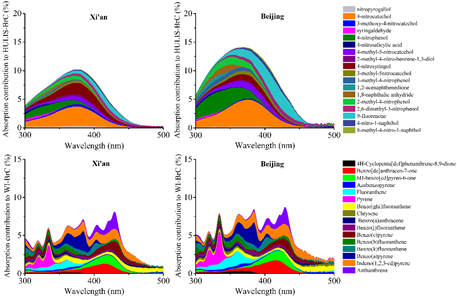Huang, R. J.*, Yang L., Shen J. C., Yuan W., Gong Y. Q., Guo J., Cao W. J., Duan J., Ni H. Y., Zhu C. S., Dai W. T., Li Y. J., Chen Y., Chen Q., Wu Y. F., Zhang \ R. J., Dusek U., O’Dowd C., Hoffmann T. Water-Insoluble Organics Dominate Brown Carbon in Wintertime Urban Aerosol of China: Chemical Characteristics and Optical Properties. Environ. Sci. Technol., 2020, 54, 7836-7847.
Light absorption of solar radiation by BrC can affect the atmospheric photochemistry through decreasing the photolysis frequencies and influence the regional and global climate by changing the radiative balance. The chromophores responsible for light absorption in atmospheric brown carbon (BrC) are not well characterized, which hinders our understanding of BrC chemistry, the links with optical properties, and accurate model representations of BrC to global climate and atmospheric oxidative capacity.
A research group led by Prof. HUANG Rujin from the Institute of Earth Environment (IEE) of the Chinese Academy of Sciences, applied a high-performance liquid chromatograph (HPLC) coupled with photodiode array (PDA) and high-resolution Orbitrap mass spectrometer (HRMS) to investigate the optical properties and chromophores composition of BrC fractions with different polarities from Urban aerosol of Xi’an and Beijing in winter 2013-2014.
We found that Water-insoluble BrC (WI-BrC) fraction dominates the total BrC absorption at 365 nm in both Xi’an (51 ± 5%) and Beijing (62 ± 13%), followed by a humic-like fraction (HULIS-BrC) and high-polarity water-soluble BrC. These three BrC fractions show large differences in optical properties and chromophore composition.
The major chromophores identified in HULIS-BrC are nitrophenols and carbonyl oxygenated polycyclic aromatic hydrocarbons (OPAHs) with 2-3 aromatic rings (in total 18 species), accounting for 10% and 14% of the light absorption of HULIS-BrC at 365 nm in Xi’an and Beijing, respectively. In comparison, the major chromophores identified in WI-BrC are PAHs and OPAHs with 4-6 aromatic rings (in total 16 species), contributing 6% and 8% of the light absorption of WI-BrC at 365 nm in Xi’an and Beijing, respectively.
This study, published in Environ. Sci. Technol., enhanced our understanding of the links between BrC chromophores composition and optical properties and was profound for the accurate estimation of the climatic and environmental effects of atmospheric BrC.

Figure 1. Time series of (a) the main PM2.5 species (OM = 1.5 × OC) and (b) the light absorption coefficients of BrC fractions at 365 nm (Abs365) and the concentrations of HULIS-C, WSOC, and OC. The pie charts in panel (b) represent the mean percentages of individual OC and BrC fractions. The white slices in the pie charts of BrC fractions represent the light absorption caused by intermolecular interactions or complex formation between HULIS and HP-WSOC.

Figure 2. Relative contributions of the identified main BrC chromophores with respect to the total light absorption by BrC fractions (HULIS-BrC and WI-BrC) over the wavelength range of 300-500 nm in Xi’an and Beijing.

